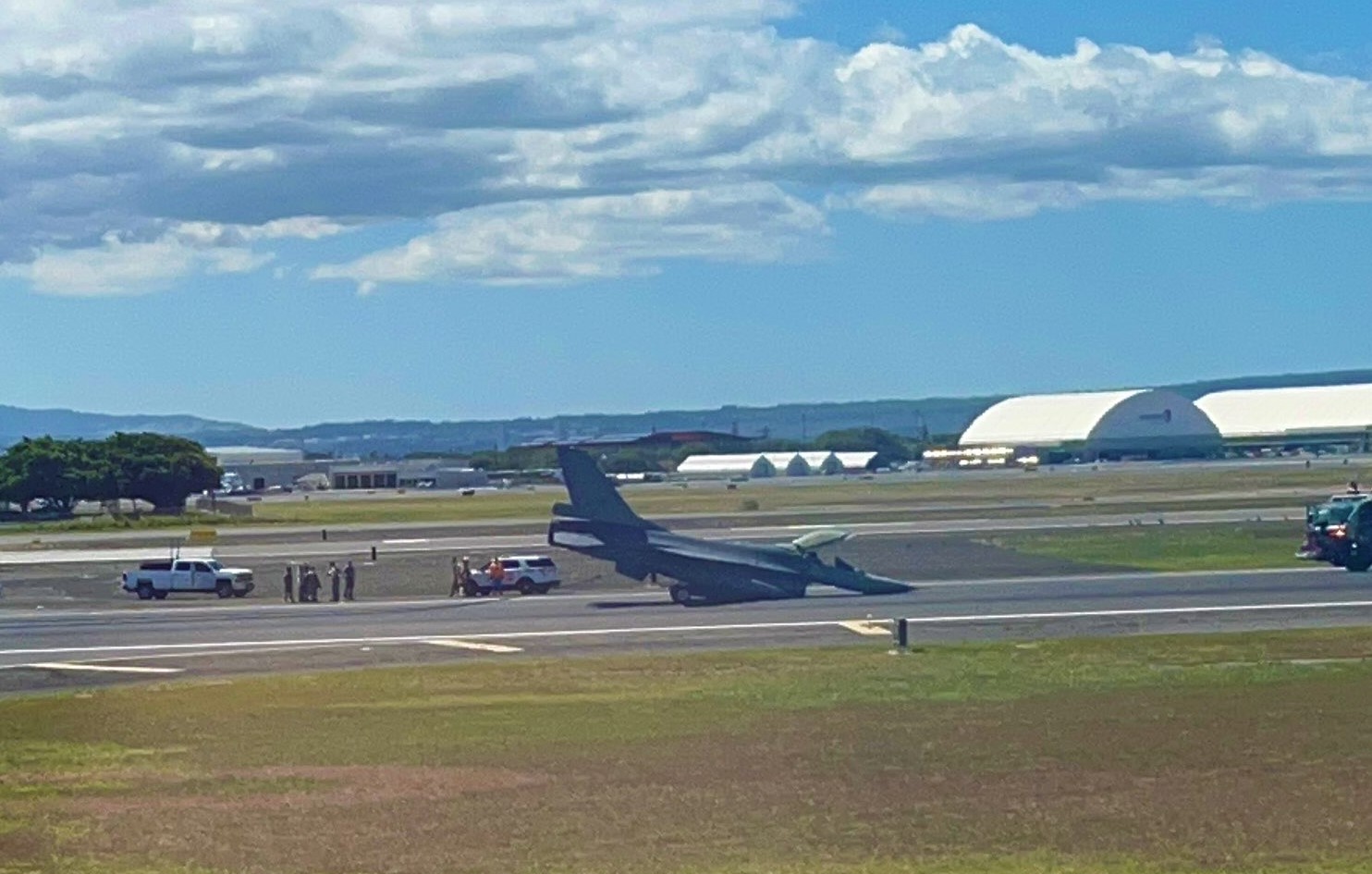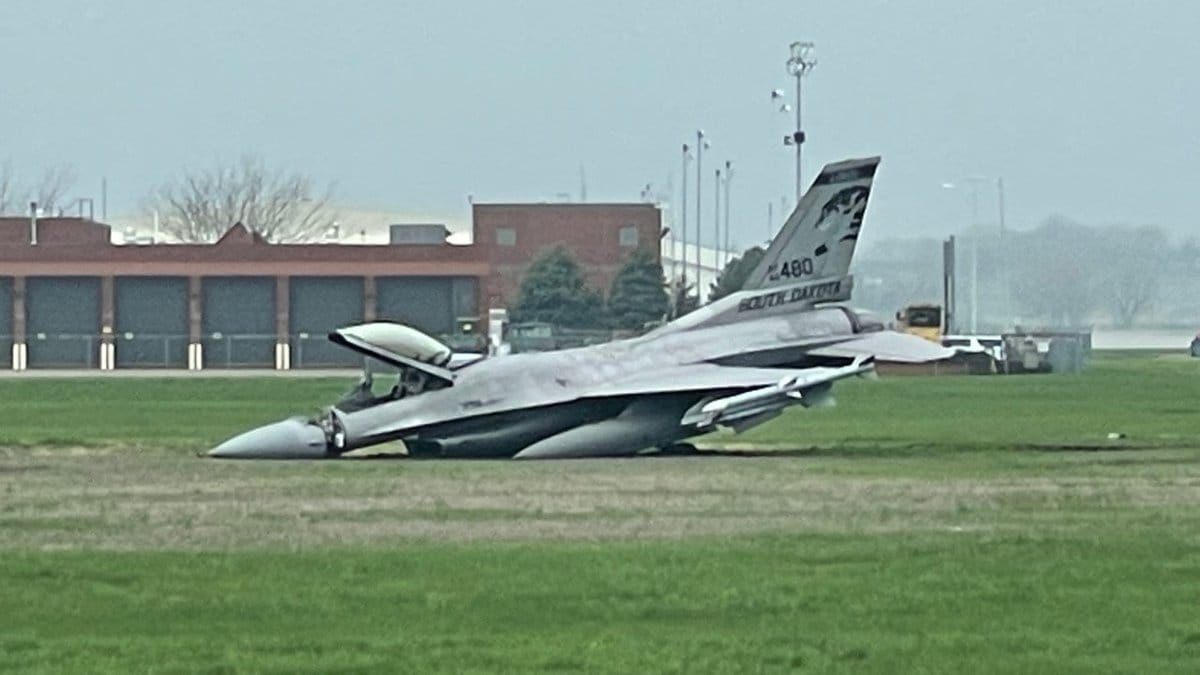The F-16, one of the world’s most trusted fighter jets, has been garnering widespread attention. From selling the most advanced Viper variant to Taiwan to a potential transfer to estranged partner Turkey – this 4th-gen warplane has managed to remain in the news.
Mission 2027 – Chinese Military Will Be ‘Ready For Action’ Against Taiwan & Allies In 5 Years – Defense Ministry
In terms of global sales, the F-16 fighters remain in the greatest demand and are operated by air forces of more than 20 countries. However, a series of mishaps with the F-16s in just over a month has raised many eyebrows.
This week, a Taiwanese F-16 had to make an emergency landing at Daniel K. Inouye International Airport in Honolulu, Hawaii, due to a landing gear failure.
While the pilot remained safe, this was the third occasion in less than a month that an F-16’s nose gear failed during landing.
In the Hawaii incident, a Republic of China Air Force (Taiwan) F-16A was purportedly flown by a US Air Force pilot out of Luke Air Force Base in Arizona. The aircraft was reportedly returning to Taiwan as part of a security assistance program to upgrade the jets to the more contemporary F-16 Viper standard.

The F-16A’s front landing gear failed to deploy on approach, resulting in a “hard landing,” as described by the Hawaii Department of Transportation (DOT). The aircraft’s nose dropped atop the tarmac.
The Hawaii DOT stated the pilot resorted to making use of the jet’s tail hook in an attempt to halt the aircraft, which is the standard procedure in many situations where the stability of an Air Force fighter’s gear is unknown.
A tail hook is a device attached to the rear of some military fixed-wing aircraft. The hook is used to achieve rapid deceleration during emergency landings or aborted takeoffs at properly equipped airports.
Since Hickam AFB and its F-22 squadron are co-located there, multiple runways at Hawaii’s major airport have retractable arresting cables.
The pilot was reportedly flying to and from Luke AFB, where Taiwanese F-16 pilots are trained, which would explain why he ended up in Honolulu’s Daniel K. Inouye International Airport.
Due to Taipei’s tense relationship with Beijing, the movement of Taiwanese fighters abroad is rarely reported.
China takes a strong exception to military cooperation between Taiwan and the West and considers it a departure from the mutually agreed upon ‘One China’ principle.
Hawaii is frequently used by Taiwanese military aircraft as a transit point across the Pacific, like many other warplanes of US partners and allies.
After an officer from the Hawaii National Guard said the jet was assigned to the Honolulu-based unit, some media agencies incorrectly reported that the aircraft belonged to the US Air Force’s 15th Fighter Wing.
This is the second untoward incident involving the ROCAF’s F-16. In January this year, the upgraded F-16 Viper aircraft went missing and was later reported to have crashed during a routine rehearsal.
Taiwan commissioned 64 F-16 Vipers in service in November last year, and the first squadron was deployed this year in January.
However, the bigger problem is that this is the third incident in over a month. Even though the investigation into the incident has been launched, it could be a deeply concerning precedent for the US Air Force and for more than 20 countries that operate the various versions of the F-16 Fighting Falcon.
Is There A Pattern Of ‘Landing Gear’ Failure
The first incident occurred on May 11 when an F-16 belonging to the South Dakota Air National Guard’s 114th Fighter Wing unit skidded off the end of Runway 15 at Joe Foss Field in Sioux Falls after returning from a routine training mission.

The second incident occurred only a few weeks later, on May 31, when an F-16C aircraft also assigned to the 114th Fighter Wing had a similar landing accident.
This time, the plane landed on Runway 33 rather than Runway 15, and it was confirmed that it was returning from another routine training run. The pilots involved in both incidents made it out alive.
A recurring occurrence in all three mishaps is that the nose of the F-16s appeared to take the brunt of the damage on all the occasions.
While their engines would have been in significant danger of swallowing debris as well, there’s greater damage to the radar and many of the jet’s critical avionics that is housed in the nose.
Additionally, landing a nose-down can also put a lot of strain on the overall airframe.
Back in 2020, it was reported that a long-standing problem with F-16 landing gear was responsible for the December 2019 crash of a Viper upon landing at Kunsan Air Base, South Korea.
An Air Force-wide time compliance technical order was issued in response to reported concerns with actuators and brackets on the main landing gear of F-16C aircraft, which had not been repaired on the 80th Fighter Squadron F-16 involved in the tragedy, according to an Air Force investigation.

When asked by EurAsian Times whether the nose gear landing failure was a concerning pattern, military expert Abhijit Iyer Mitra said, “I don’t think three nose gear collapses in the space of this year out of over 4600 produced can be classified as a problem. Given the high stresses and usage of these aircraft – this is minuscule.”
The runway at the airport appears to have escaped damage, but it will remain closed until the plane has been removed.
No evidence could establish a connection between these three crashes. More clarity would be achieved when the US Air Force finally closes its investigation into the crash.
There were 42 Class A or Class B mishaps involving Air Force F-16s from the fiscal year 2015 through the fiscal year 2021, with 20 of them resulting in aircraft destruction, according to Air Force Magazine.
Class A accidents result in death or permanent injury, damage of more than $2.5 million, or the loss of an aircraft. Class B mishaps result in permanent partial disability, damage valued between $600,000 and $2.5 million, or the hospitalization of three people.
According to the Air Force Safety Center data, the F-16 has a rate of 3.38 Class A and B accidents per 100,000 flying hours, which is higher than the A-10 but lower than the F-15, F-22, and F-35.
The F-16s of Taiwan being lost to unavoidable crashes could not be a good omen for a country that is relentlessly boosting its military in the face of a potential Chinese invasion. For the US, there might be a need to thoroughly study the cause of the crashes and fill the loopholes.
- Contact the author at sakshi.tiwari9555@gmail.com
- Follow EurAsian Times on Google News




